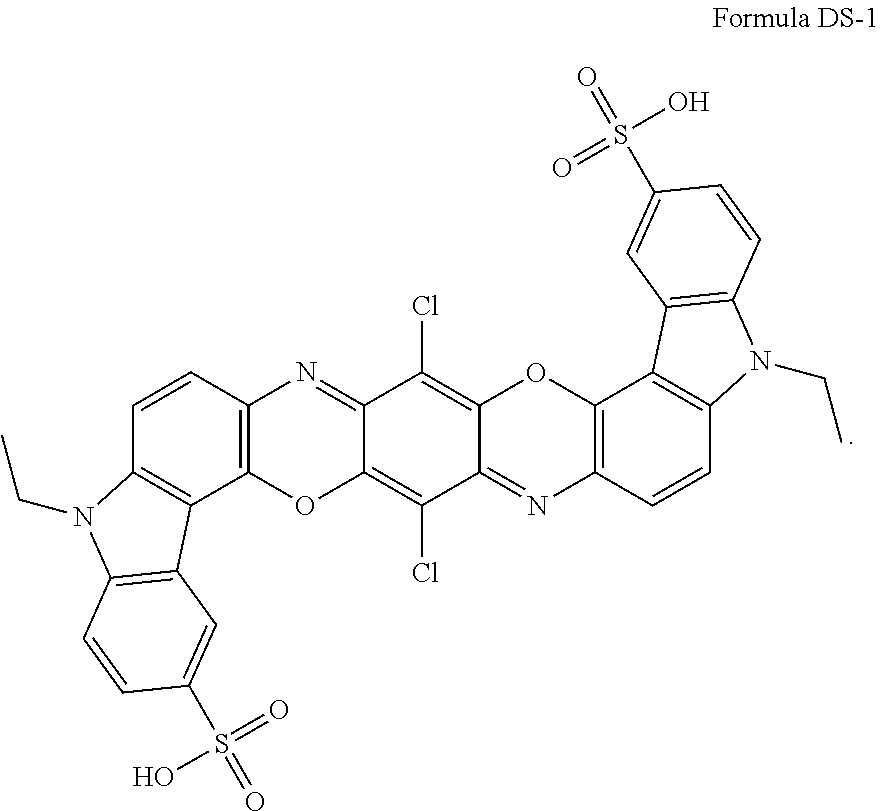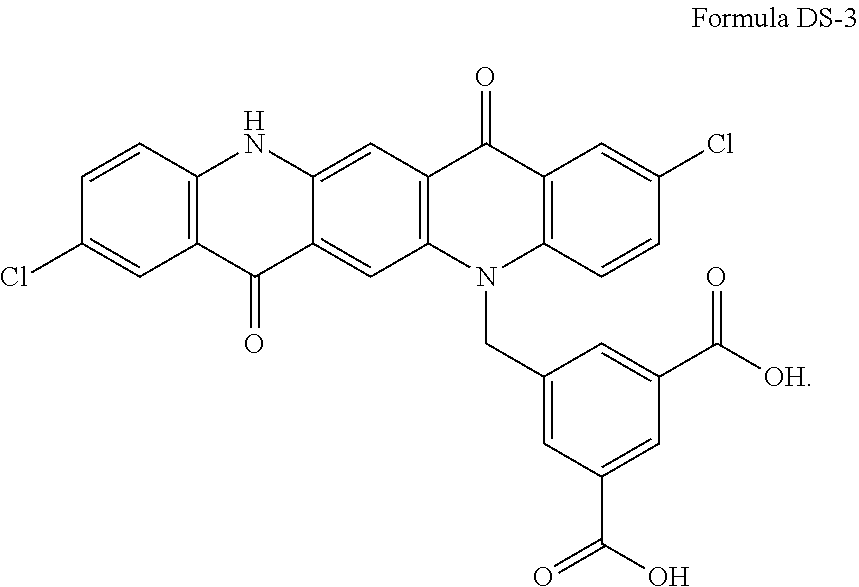Preparing and dispersing surface-modified colour pigments
a technology of colour pigments and surface modifications, applied in the field of surface-modified colour pigments, can solve the problems of chemical burn on the skin of operators, poor and difficult preparation of thermally stable non-aqueous dispersions with submicron particles, and achieves minimal health and environmental impacts, high dispersion quality, and enhanced dispersion quality and stability.
- Summary
- Abstract
- Description
- Claims
- Application Information
AI Technical Summary
Benefits of technology
Problems solved by technology
Method used
Image
Examples
example 1
[0166]This example illustrates the simplicity of the method for preparing a pigment according to a preferred embodiment of the present invention.
Preparation of sulfonated pigment SPV-9
[0167]The pigment SPV-9 was prepared using the conditions as mentioned in Table 2.
[0168]
TABLE 2SulfonationacetonitrilesolventSulfonatingagentTypesulfuric acidAmount20.0 wt % based on the weight ofthe pigmentReactionconditionsTemperature80° C.Time8 hoursWashing liquidwater
[0169]A mixture of 50 g of the starting pigment PV23, 380 mL acetonitrile and 10.0 g sulfuric acid is placed in a vessel open only at the top. This vessel is connected to a Liebig condenser and the mixture is refluxed for 8 hours. The mixture is then cooled to 20° C. and filtered. The filtrand was washed with water until a pH of 5 was reached by the filtrate. The filtrand was dried overnight at 40° C. in a vacuum oven. 47 g of a violet powder were recovered.
example 2
[0170]This example illustrates the effect of the reaction conditions on the dispersion quality and stability of the sulfonated pigments in inkjet inks.
Preparation of pigments
[0171]The pigments SPV-1 to SPV-8 and SPV-10 to SPV-18 were prepared in exactly the same manner as SPV-9 in Example 1 except that the reaction conditions according to Table 3 were used.
[0172]
TABLE 3ReactionSulfonatingconditionsSulfonationagentWashingTempTimePigmentsolventTypewt %liquid(° C.)(h)SPV-1acetonitrileH2SO42acetonitrile8024SPV-2acetonitrileH2SO42water +8024acetonitrileSPV-3acetonitrileH2SO42water +8048acetonitrileSPV-4acetonitrileH2SO45water808SPV-5acetonitrileH2SO45water8016SPV-6acetonitrileH2SO45acetonitrile8024SPV-7acetonitrileH2SO45water +8024acetonitrileSPV-8acetonitrileH2SO410water808SPV-9acetonitrileH2SO420water808SPV-10acetonitrileH2SO440water802SPV-11acetonitrileH2SO440water804SPV-12acetonitrileH2SO440water808SPV-13propionitrileH2SO440water808SPV-14ethylacetateH2SO440water798SPV-15sulfolaneH2SO...
example 3
[0185]This example illustrates that the method for preparing a pigment according to a preferred embodiment of the present invention can be used for some other pigments.
Preparation of Pigments
[0186]The pigments SPR-1 to SPR-9 and SPO-1 to SPO-6 were prepared in exactly the same manner as SPV-9 in Example 1 except that the starting pigments and the reaction conditions according to Table 6 were used. For pigment, a dispersion synergist was used to “sulfonate” the starting pigment PR176.
[0187]
TABLE 6ReactionSulfonatingconditionsStartingSulfonationagentTempTimePigmentPigmentsolventTypewt %(° C.)(h)SPR-1PR214acetonitrileH2SO440808SPR-2PR176acetonitrileDS-211808SPR-3PR176ethylacetateH2SO440798SPR-4PR176waterH2SO440808SPR-5PR176acetonitrileH2SO440808SPR-6PR146acetonitrileH2SO440808SPR-7PR122acetonitrileH2SO440808SPR-8PV19acetonitrileH2SO440808SP0-1PO34acetonitrileH2SO440808SP0-2PO34ethylacetateH2SO440808SP0-3PO34waterH2SO440808SP0-4PO13ethylacetateH2SO440808SP0-5PO13waterH2SO440808SP0-6PO13...
PUM
| Property | Measurement | Unit |
|---|---|---|
| temperature | aaaaa | aaaaa |
| temperature | aaaaa | aaaaa |
| temperature | aaaaa | aaaaa |
Abstract
Description
Claims
Application Information
 Login to View More
Login to View More - R&D
- Intellectual Property
- Life Sciences
- Materials
- Tech Scout
- Unparalleled Data Quality
- Higher Quality Content
- 60% Fewer Hallucinations
Browse by: Latest US Patents, China's latest patents, Technical Efficacy Thesaurus, Application Domain, Technology Topic, Popular Technical Reports.
© 2025 PatSnap. All rights reserved.Legal|Privacy policy|Modern Slavery Act Transparency Statement|Sitemap|About US| Contact US: help@patsnap.com



